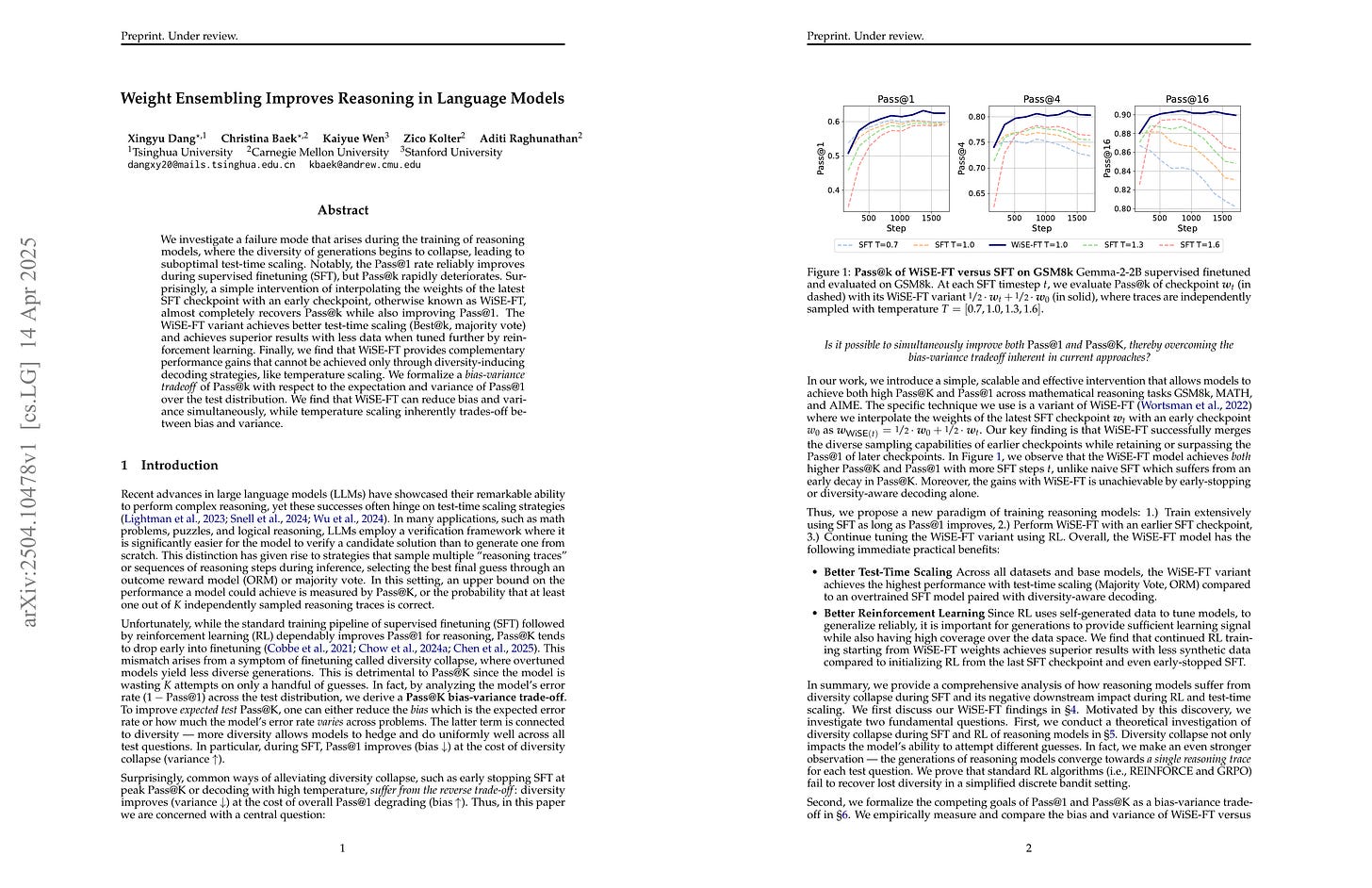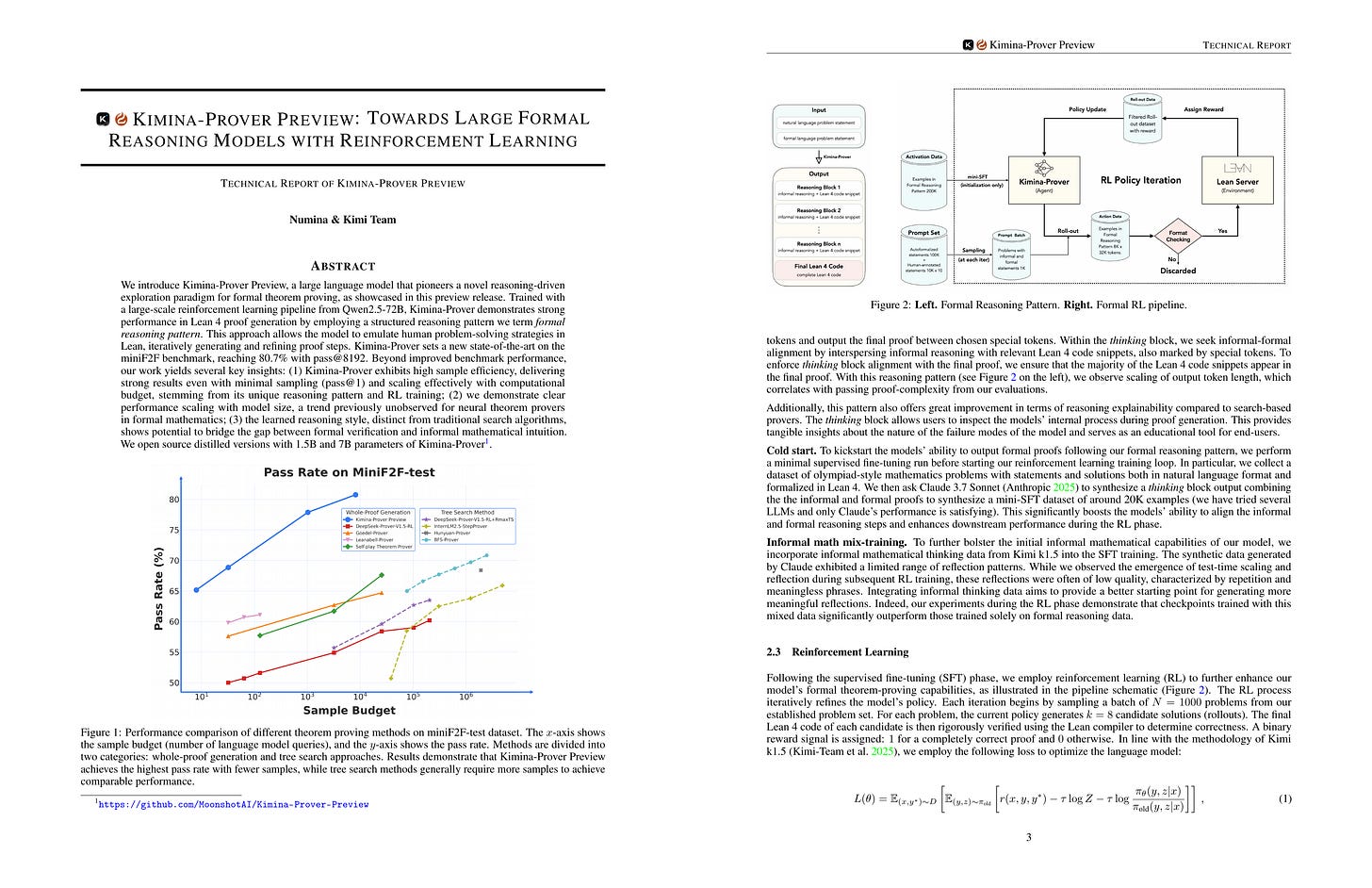2025년 4월 15일
Reasoning Models Can Be Effective Without Thinking
(Wenjie Ma, Jingxuan He, Charlie Snell, Tyler Griggs, Sewon Min, Matei Zaharia)
Recent LLMs have significantly improved reasoning capabilities, primarily by including an explicit, lengthy Thinking process as part of generation. In this paper, we question whether this explicit thinking is necessary. Using the state-of-the-art DeepSeek-R1-Distill-Qwen, we find that bypassing the thinking process via simple prompting, denoted as NoThinking, can be surprisingly effective. When controlling for the number of tokens, NoThinking outperforms Thinking across a diverse set of seven challenging reasoning datasets--including mathematical problem solving, formal theorem proving, and coding--especially in low-budget settings, e.g., 51.3 vs. 28.9 on ACM 23 with 700 tokens. Notably, the performance of NoThinking becomes more competitive with pass@k as k increases. Building on this observation, we demonstrate that a parallel scaling approach that uses NoThinking to generate N outputs independently and aggregates them is highly effective. For aggregation, we use task-specific verifiers when available, or we apply simple best-of-N strategies such as confidence-based selection. Our method outperforms a range of baselines with similar latency using Thinking, and is comparable to Thinking with significantly longer latency (up to 9x). Together, our research encourages a reconsideration of the necessity of lengthy thinking processes, while also establishing a competitive reference for achieving strong reasoning performance in low-budget settings or at low latency using parallel scaling.
추론 모델을 추론하지 않게 했을 때의 Inference Time Scaling. 이런 결과가 나오는 이유에 대해 생각해볼 필요는 있겠네요.
Inference time scaling when let reasoning models not to reason. It's worth considering why these results occur.
#reasoning #inference-time-scaling
The Scalability of Simplicity: Empirical Analysis of Vision-Language Learning with a Single Transformer
(Weixian Lei, Jiacong Wang, Haochen Wang, Xiangtai Li, Jun Hao Liew, Jiashi Feng, Zilong Huang)
This paper introduces SAIL, a single transformer unified multimodal large language model (MLLM) that integrates raw pixel encoding and language decoding within a singular architecture. Unlike existing modular MLLMs, which rely on a pre-trained vision transformer (ViT), SAIL eliminates the need for a separate vision encoder, presenting a more minimalist architecture design. Instead of introducing novel architectural components, SAIL adapts mix-attention mechanisms and multimodal positional encodings to better align with the distinct characteristics of visual and textual modalities. We systematically compare SAIL's properties-including scalability, cross-modal information flow patterns, and visual representation capabilities-with those of modular MLLMs. By scaling both training data and model size, SAIL achieves performance comparable to modular MLLMs. Notably, the removal of pretrained ViT components enhances SAIL's scalability and results in significantly different cross-modal information flow patterns. Moreover, SAIL demonstrates strong visual representation capabilities, achieving results on par with ViT-22B in vision tasks such as semantic segmentation. Code and models are available at https://github.com/bytedance/SAIL.
이미지 인코더 없는 멀티모달 모델 디자인이 다시 나오기 시작하는군요. Bidirectional Attention 같은 그 나름대로 성가신 요소들이 추가되긴 했습니다만.
Multimodal model designs without an image encoder are starting to resurface. Although some cumbersome elements like bidirectional attention have been incorporated.
#multimodal
Weight Ensembling Improves Reasoning in Language Models
(Xingyu Dang, Christina Baek, Kaiyue Wen, Zico Kolter, Aditi Raghunathan)
We investigate a failure mode that arises during the training of reasoning models, where the diversity of generations begins to collapse, leading to suboptimal test-time scaling. Notably, the Pass@1 rate reliably improves during supervised finetuning (SFT), but Pass@k rapidly deteriorates. Surprisingly, a simple intervention of interpolating the weights of the latest SFT checkpoint with an early checkpoint, otherwise known as WiSE-FT, almost completely recovers Pass@k while also improving Pass@1. The WiSE-FT variant achieves better test-time scaling (Best@k, majority vote) and achieves superior results with less data when tuned further by reinforcement learning. Finally, we find that WiSE-FT provides complementary performance gains that cannot be achieved only through diversity-inducing decoding strategies, like temperature scaling. We formalize a bias-variance tradeoff of Pass@k with respect to the expectation and variance of Pass@1 over the test distribution. We find that WiSE-FT can reduce bias and variance simultaneously, while temperature scaling inherently trades-off between bias and variance.
SFT 초반과 후반의 Weight에 대한 Averaging으로 샘플 다양성의 감소를 억제할 수 있다는 결과. 다양성의 중요성을 고려하면 중요한 트릭이 될 듯 하네요.
This result shows that we can suppress the decrease in sample diversity by averaging the weights from the early and late stages of SFT. Considering the importance of diversity, this could become an important trick.
#ensemble #reasoning
REPA-E: Unlocking VAE for End-to-End Tuning with Latent Diffusion Transformers
(Xingjian Leng, Jaskirat Singh, Yunzhong Hou, Zhenchang Xing, Saining Xie, Liang Zheng)
In this paper we tackle a fundamental question: "Can we train latent diffusion models together with the variational auto-encoder (VAE) tokenizer in an end-to-end manner?" Traditional deep-learning wisdom dictates that end-to-end training is often preferable when possible. However, for latent diffusion transformers, it is observed that end-to-end training both VAE and diffusion-model using standard diffusion-loss is ineffective, even causing a degradation in final performance. We show that while diffusion loss is ineffective, end-to-end training can be unlocked through the representation-alignment (REPA) loss -- allowing both VAE and diffusion model to be jointly tuned during the training process. Despite its simplicity, the proposed training recipe (REPA-E) shows remarkable performance; speeding up diffusion model training by over 17x and 45x over REPA and vanilla training recipes, respectively. Interestingly, we observe that end-to-end tuning with REPA-E also improves the VAE itself; leading to improved latent space structure and downstream generation performance. In terms of final performance, our approach sets a new state-of-the-art; achieving FID of 1.26 and 1.83 with and without classifier-free guidance on ImageNet 256 x 256. Code is available at
https://end2end-diffusion.github.io
.
VAE와 Diffusion을 같이 학습시키려는 시도. 여기에서도 Representation에 대해 DINOv2로 Regularization을 걸어주는 게 중요했네요 (https://arxiv.org/abs/2504.08736).
An attempt to train VAE and diffusion models together. Here too, regularizing the representation using DINOv2 was crucial (https://arxiv.org/abs/2504.08736).
#tokenizer #diffusion
Kimina-Prover Preview: Towards Large Formal Reasoning Models with Reinforcement Learning
(Numina & Kimi Team)
We introduce Kimina-Prover Preview, a large language model that pioneers a novel reasoning-driven exploration paradigm for formal theorem proving, as showcased in this preview release. Trained with a large-scale reinforcement learning pipeline from Qwen2.5-72B, Kimina-Prover demonstrates strong performance in Lean 4 proof generation by employing a structured reasoning pattern we term formal reasoning pattern. This approach allows the model to emulate human problem-solving strategies in Lean, iteratively generating and refining proof steps. Kimina-Prover sets a new state-of-the-art on the miniF2F benchmark, reaching 80.7% with pass@8192. Beyond improved benchmark performance, our work yields several key insights: (1) Kimina-Prover exhibits high sample efficiency, delivering strong results even with minimal sampling (pass@1) and scaling effectively with computational budget, stemming from its unique reasoning pattern and RL training; (2) we demonstrate clear performance scaling with model size, a trend previously unobserved for neural theorem provers in formal mathematics; (3) the learned reasoning style, distinct from traditional search algorithms, shows potential to bridge the gap between formal verification and informal mathematical intuition. We open source distilled versions with 1.5B and 7B parameters of Kimina-Prover1.
Lean 4를 사용한 형식적 증명에 대한 추론 RL. Autoformalization이 계속 문제이지만 형식화가 된 문제에 대해서 하지 않을 이유는 없겠죠.
Reasoning RL for formal theorem proving using Lean 4. While autoformalization remains a challenge, there's no reason not to apply this approach to formalized problems.
#math #reasoning #rl









